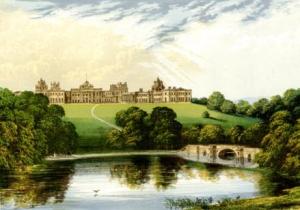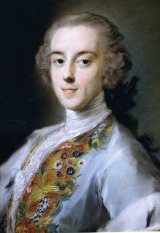
This day in London history: on 24 January 1726 Sir John Vanbrugh was probably born; in any event, he was baptised on this day at his parents’ home in London. A playwright and architect, possibly his best known work as the first is The Provok’d Wife and, as the second, Blenheim Palace.
Vanbrugh was a member of the Kit-Kat Club, a club founded in 1700 by a bookseller called Jacob Tonson. There is a Kitcat Terrace in the East London district of Bow, but it has nothing to do with the club. It rather sedately commemorates the Reverend Henry James Kitcat, rector of St Mary-le-Bow from 1904 to 1921. The name derives from Kitcott, a place name in Devon.

The Kit-Kat Club was comprised of Whig Patriots dedicated to ensuring that Protestants would continue on the throne after the reign of William III. They were also dedicated to eating, drinking, and hanging out together. Women appeared in the club only as the focus of toasts. Horace Walpole, son of Sir Robert Walpole, who was generally regarded as the first Prime Minister of Great Britain, referred to the club as “a set of wits, in reality the patriots that saved Britain”.
Members of the club also included William Congreve, John Vanbrugh, Matthew Prior, Joseph Addison and Richard Steele. After George I succeeded to the throne in 1714, the original purpose of the club had been served, and it was disbanded by 1720.
The club first met at a tavern in Shire Lane off Fleet Street, and later at the Fountain Tavern on the Strand. In the summer the club repaired to the Upper Flask tavern in Highgate for their meetings. The club took its name from the proprietor (Christopher (Kit) Kat, whose name is also given as Cat, Catt, Katt, and even Catling ) landlord of the Shire Lane tavern off Fleet Street, where the members used to dine. One of his specialities was a sumptuous mutton pie that he called a Kit-Kat. That seemed, to the founding members, as good a name for a club as any.

Alexander Pope whimsically referred to the club and its name in verse:
Whence deathless Kit-Cat took its name
Few critics can unriddle
Some say from Pastry Cook it came,
And some from Cat and Fiddle
Cat and Fiddle was an old tavern name that many have speculated over. The simplest is that it comes from the nursery thyme (Hey, diddle diddle, the cat and the fiddle, the cow jumped over the moon…), though while the pub name dates back to at early as 1589 the date of the rhyme is not certain.
Other explanations are that it was from the faithful feline (chatte fidèle) companion of an unknown Frenchman, or from the wife of Peter the Great of Russian, Catherine la Fidèle. The problem with that one is that the sign existed over a century before Catherine, but as with these street name stories, fact shouldn’t get in the way of an interesting theory.

Although, sad to say, there are no streets named Cat and Fiddle, there is a Cat and Mutton Bridge in Hackney. Until December of last year, there was still a Cat and Mutton pub located here, but which came first and what the original name was is not clear. One version of the name is that it was originally Shoulder of Mutton and Cat from the ‘cats’ or coal barges that would have gone under the bridge on the nearby Regents Canal; there is also a Sheep Lane nearby that ties in with the mutton side of things.
Another version is that it was originally the Cattle and Shoulder of Mutton; also from the “many drovers and agricultural workers arriving in London to sell there various beasts in the markets in what now is known as the city”.
The old inn sign, at one time, had two verses on it:
Pray, Puss, do not tare,
Because the mutton is so rare
and
Pray, Puss do not claw,
Because the mutton is so raw

6 responses to “The Kit-Kat Club and the Cat and Mutton”
The other term derived from the Kit-Kat club is the kit-kat portrait, which is less than half-length but shows the hands. Quoting Wikipedia (sorry): “The name originates from a famous series of portraits which were commissioned from Godfrey Kneller for members of the Kit-Cat Club… The size is said to have been determined because the dining-room ceiling of the Kit-Kat Club was too low for half-size portraits of the members.”
Thanks for that. I knew the portraits of the members existed but didn’t realize it was a generic term for that size portrait.
[…] often featured animals. Some of the quirkier names include Fox and Knot Street in the City, and Cat and Mutton Bridge in East […]
[…] is tenuous enough that she doesn’t really have a connection with the terrace, but rather with the Kit-Kat Club, founded in 1700 by a bookseller called Jacob Tonson. The club was comprised of Whig Patriots […]
[…] is also a Cat and Mutton Bridge in Hackney, named from a tavern formerly called the Shoulder of Mutton and Cat and now called the […]
[…] [4] The Kit-Cat Club and the Cat & Mutton. https://thestreetnames.com/2014/01/24/the-kit-kat-club-and-the-cat-and-mutton/ […]